Art & Exhibitions
World’s Top 20 Biennials, Triennials, and Miscellennials
The artnet News power ranking of biennials.
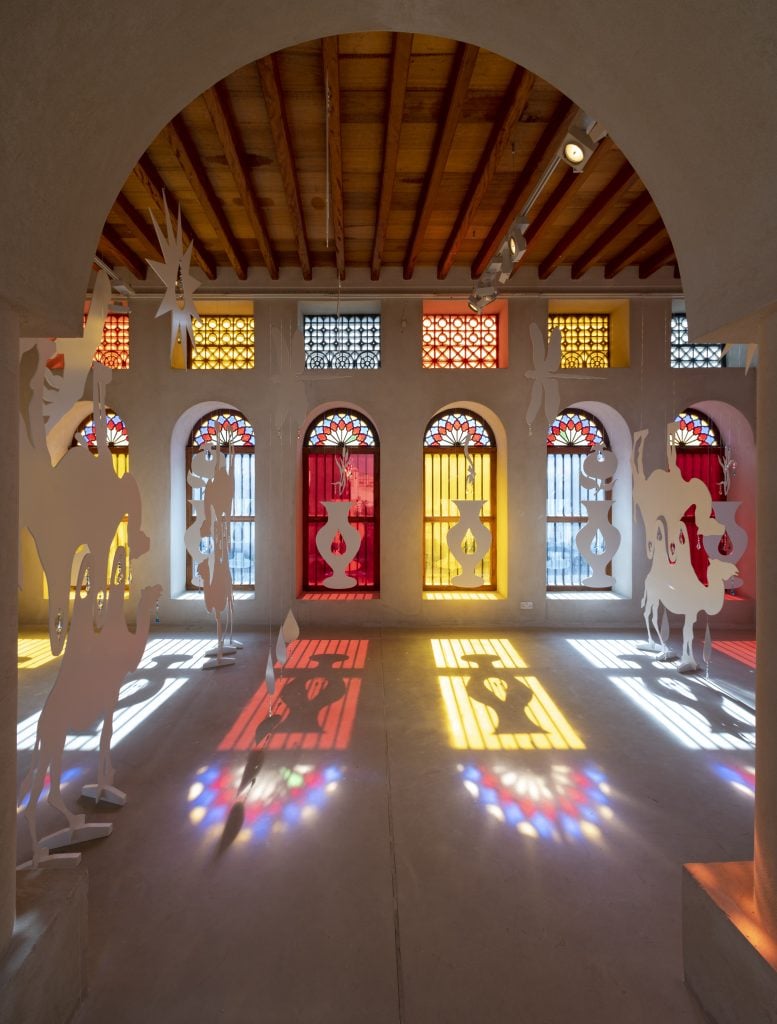
The artnet News power ranking of biennials.

Artnet News

Just as the art world calendar has filled up with fairs, so the number of biennials, triennials, quadrennials, and quinquennials spanning the globe has proliferated over the past two decades. The explosion of –ennials has reached such a pace that there’s an entire organization, the Greco-Dutch group the Biennial Foundation, devoted to cataloging all of them. The global biennial circuit was even the subject of a recent conference, “Biennials: Prospect and Perspectives,” at the Center for Art and Media Karlsruhe in Germany. Topics of discussion included “Biennials and Public Space,” “Chances and Limitations of Biennials in the Context of Marketing and Policies,” and “Biennials as Motor for Social Change.”
Biennials, in other words, are a big deal and big business, with many cities launching high-profile recurring exhibitions in a bid to attract tourists, commerce, and cultural capital. But which ones should you be making regular pilgrimages to, and which ones can you skip? Herewith, artnet News ranks the world’s 20 most important biennials. (Of the 20 on this list, 11 are either currently open or will open in the next six months, so start booking those flights!)
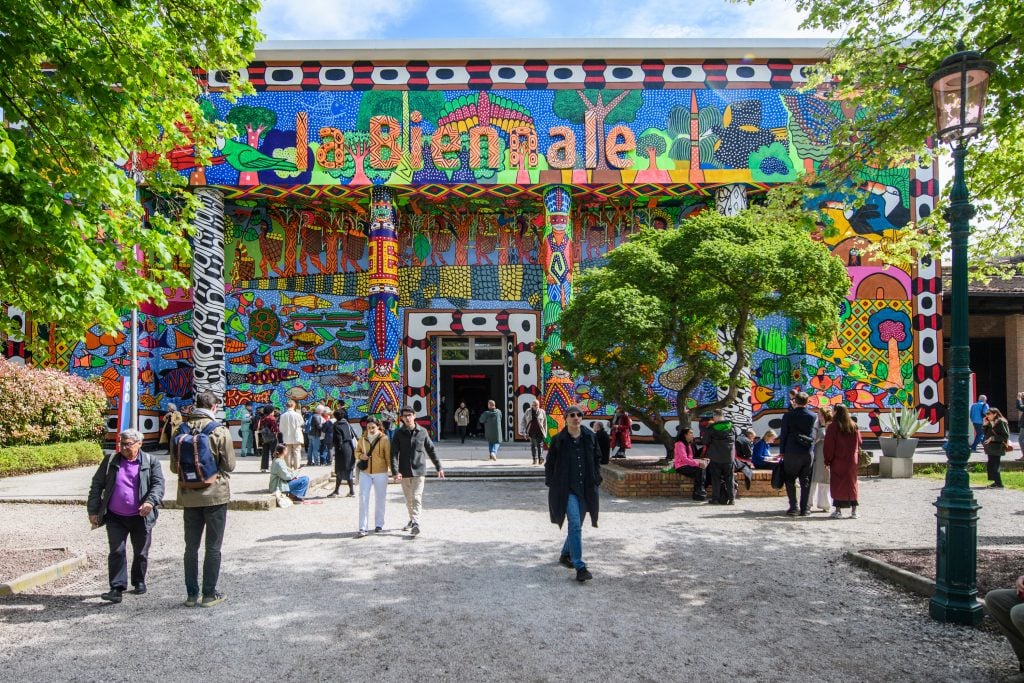
Visitors enter into the main pavilion at the Giardini during the 60th Biennale Art 2024 on April 18, 2024 in Venice, Italy. Photo by Simone Padovani/Getty Images.
1. La Biennale di Venezia
The granddaddy of the global biennial circuit, Venice is a must-visit on every art world denizen’s calendar. Between the Olympics-like competition among countries with permanent pavilions in the Giardini and the Arsenale, or pop-up pavilions peppered around the city, and the marquee curatorial effort that forms its centerpiece, this is contemporary art’s big dance, where art stars and major curators are discovered, vetted, and honored.
Stats Sheet
Year founded: 1895.
Takes place every: Two years.
Current edition: 56th edition (in 2015).
Current curator: Okwui Enwezor (in 2015).
Previous curator: Massimiliano Gioni (in 2013).
Countries represented: 88 (in 2013).
Artists included: More than 150 (in 2013).
Attendance: More than 475,000 (in 2013).
Important dates: The 56th edition runs May 9 to November 22, 2015.
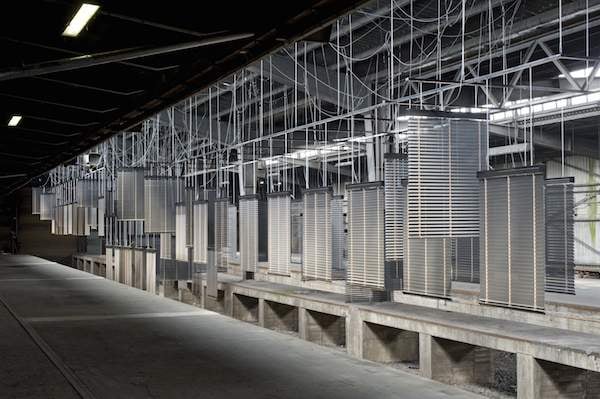
Haegue Yang, Approaching: Choreography Engineered in Never-Past Tense (2012) at dOCUMENTA (13).
Photo: Nils Klinger.
2. Documenta
Every five years, the art world makes a pilgrimage to the small German city of Kassel to get a bead on what’s more often than not contemporary art’s intellectual agenda for the following half decade. Founded in 1955, the show was a more regionally focused affair at the outset, aimed at smiting the Nazi-imposed ban on so-called degenerate art and unifying the geopolitically divided country on the basis of culture—Kassel was chosen uncoincidentally for its most central location of any German city. Recent Documenta have expanded dramatically thanks in no small part to its status as the most well-funded iterative exhibition. In 2012 Carolyn Christov-Bakargiev’s dOCUMENTA (13) spanned the entire city, using 32 venues including the Karlsaue park. While it is accompanied by no shortage of dinners and parties, the exhibition’s less glamorous locale (compared to other biennials) and the stringently intellectual curatorial approach make Documenta’s critical examination of the art world itself uniquely sharp.
Stats Sheet
Year founded: 1955.
Takes place every: Five years.
Current edition: 14th edition (in 2017).
Current curator: Adam Szymczyk (in 2017).
Previous curator: Carolyn Christov-Bakargiev (in 2012).
Artists included: Approximately 300 (in 2012).
Attendance: 905,000 (in 2012).
Important dates: The 14th edition runs June 10 to September 17, 2017.
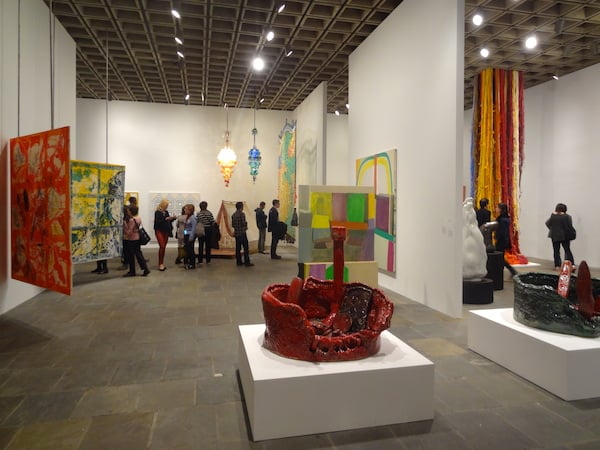
Installation view of the 2014 Whitney Biennial.
Photo: Benjamin Sutton
3. The Whitney Biennial
The foremost recurring exhibition in the US and a favorite critical punching bag, the Whitney Biennial nevertheless remains a rite of passage of sorts, whether it’s for young artists being ushered into the art world hierarchy’s upper echelons, longtime favorites jump-starting late-career revivals, or, as happened two years ago with Forrest Bess, a curatorial project sparking widespread interest in a dead and long-overlooked artist. Whether panned or praised, the Whitney Biennial reliably serves as a barometer of where things stand in the US art world, and a survey of its youngest participants also doubles as an up-to-date power ranking of the country’s top MFA programs.
Stats Sheet
Year founded: 1932.
Takes place every: Two years (though for a time this was an annual exhibition).
Current edition: 77th edition (in 2014).
Current curators: Stuart Comer, Anthony Elms, and Michelle Grabner.
Previous curators: Elisabeth Sussman and Jay Sanders.
Countries represented: 13 (in 2014).
Artists included: 103 (in 2014).
Attendance: 131,471 (in 2012).
Important date: The 2014 Whitney Biennial closes May 25.
Infamous moment: In 1987 the feminist art collective the Guerrilla Girls staged an exhibition at the Clocktower Gallery entitled “Guerrilla Girls Review the Whitney,” in which they laid out figures showing the paltry representation of women artists and artists of color in that year’s Whitney Biennial.
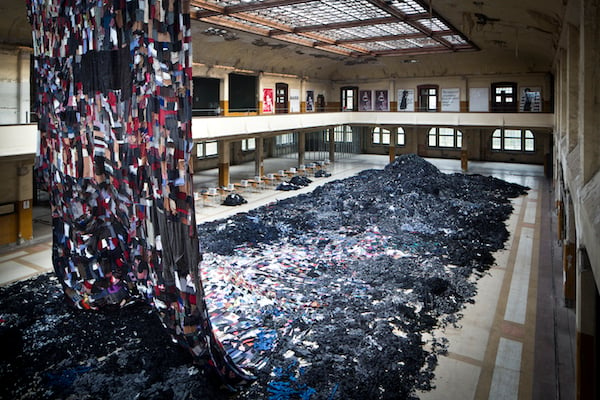
Ni Haifeng, Para-Production (2008) at Manifesta 9 in Limburg, Belgium, 2012.
Photo: Kristof Vrancken.
4. Manifesta
The roving European biennial conceived in the wake of the fall of the Soviet Union and launched in 1996 in Rotterdam—its center of operations is in Amsterdam—is very deliberate about steering clear of traditional art centers and engaging with the specificities of each edition’s host venue and city, whether it’s Ljubljana, Slovenia (in 2000) or Murcia, Spain (in 2010). That may be part of the reason why the organizers have landed in hot water over their choice of venue for the 2014 edition, which is slated to open in June at the State Hermitage Museum in St. Petersburg—hardly as off-the-art-world-map as, for instance, 2012’s venue, an abandoned coal mine in Genk, Belgium. In spite of this year’s controversy over the biennial’s perceived complicity in Russia’s assorted ongoing human rights abuses, Manifesta’s track record is one of impressive curatorial rigor (a new theme and curator, or group of curators, is chosen for each edition) and encouragement for emerging artists to create ambitious and experimental projects they might not be able to pursue in the context of a more conventional exhibition.
Stats Sheet
Year founded: 1996.
Takes place every: Two years.
Current edition: 10th edition (in 2014).
Current curator: Kasper König (in 2014).
Previous curator: Cuauhtémoc Medina (in 2012).
Artists included: 54 (in 2014).
Attendance: More than 100,000 (in 2012).
Important dates: June 28 to October 31, 2014.
Infamous moment: In 2006, Manifesta 6 was due to take place in the Cypriot capital of Nicosia. But co-curators Mai Abu ElDahab, Anton Vidokle, and Florian Waldvogel’s plan to open an avant-garde art school for short- and long-term residencies and exhibitions was met with virulent opposition from Cypriot artists and the local art community. Michael Paraskos, the Cyprus College of Art’s director of programs, wrote: “The artists of Cyprus are being treated as if they are uncivilised natives, suitable for anthropological study, and possible conversion by missionaries, but not to be treated as equals.” Manifesta 6 was ultimately canceled just three months before it was due to open.
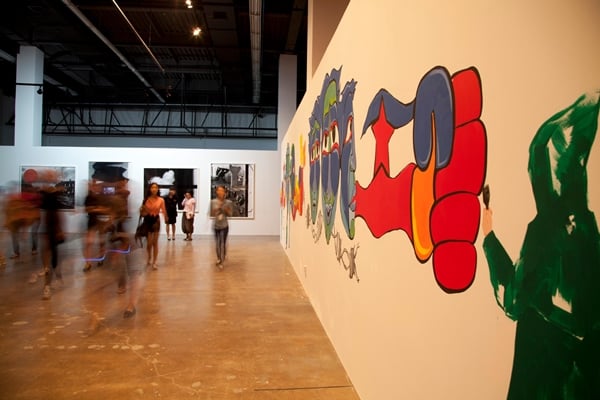
Darinka Pop-Mitić, Aktiv Solidarceo (On Solidarity series), 2005–ongoing.
Photo: Courtesy the artist.
5. Gwangju Biennale
In terms of budget, attendance, and clout, the Gwangju Biennale is undoubtedly in the first rank of world art spectaculars. Located in the cradle of Korean democracy—the 1980 Gwangju Massacre helped spur the end of the dictatorship—it has been known for staggering feats, including Okwui Enwezor’s 2008 “On the Road / Position Papers” (a sort of biennial of biennials), and Massimiliano Gioni’s 2010 “10,000 Lives” (a cosmos-spanning survey of art that prefigured the vision of his more recent Venice Biennale). It’s most recent incarnation attracted more than half a million visitors, boasting 9,000 attendees per day, and this year’s incarnation, curated by the Tate’s Jessica Morgan and titled “Burning Down the House,” promises to provoke with its theme of exploring the process of “destruction or self-destruction―burning the home one occupies―followed by the promise of the new and the hope for change.”
Stats Sheet
Year founded: 1995.
Takes place every: Two years.
Current edition: 10th edition (in 2014).
Current curator: Jessica Morgan (in 2014).
Previous curators: Nancy Adajania, Wassan Al-Khudhairi, Mami Kataoka, Sunjung Kim, Carol Yinghua Lu, and Alia Swastika (in 2012).
Countries represented: 40 (in 2012).
Artists included: 92 (in 2012).
Attendance: 620,000 (in 2012).
Important dates: The 10th edition runs September 5 to November 9, 2014.
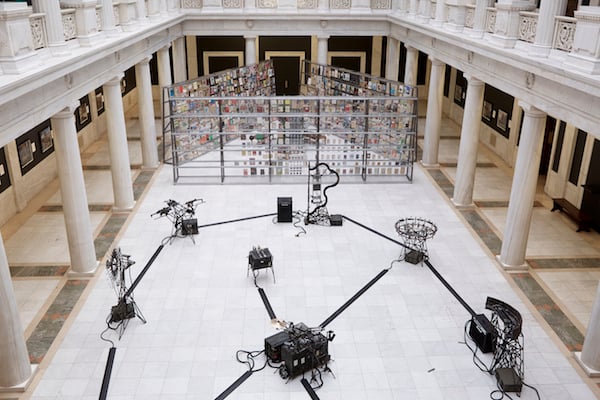
Pedro Reyes, installation view of Disarm (Mechanized), with Bidoun Library in the background.
© Pedro Reyes. Courtesy of Lisson Gallery, London. Photo: Greenhouse Media.
6. Carnegie International
Andrew Carnegie’s international art exhibition, held at his namesake Pittsburgh institution, the Carnegie Museum of Art—and used as its primary channel for acquiring contemporary art for its permanent collection—is the second-oldest recurring exhibition in the world. Launching in 1896, just one year after the first Venice Biennale, it has featured virtually every major modern artist, from Vincent van Gogh, Auguste Rodin, and James Whistler on up to Nicole Eisenman, Frances Stark, and Phyllida Barlow. Staged every three to five years, it has evolved from an educational initiative to introduce American viewers to the best art from around the world into a truly international and tightly curated showcase for fully-developed mini-shows and special projects by some of the biggest names of the day. The lineup of recent curators is similarly star-studded, and includes Richard Armstrong (in 1995), Douglas Fogle (in 2008), and Laura Hoptman (in 2004).
Stats Sheet
Year founded: 1896.
Takes place every: Three to five years.
Current edition: 56th edition (in 2013–14).
Current curators: Daniel Baumann, Dan Byers, and Tina Kukielski (in 2013–14).
Previous curator: Douglas Fogle (2008–09).
Countries represented: 19 (in 2013–14).
Artists included: 35 (in 2013–14).
Attendance: 156,451 (2013–14).
Important date: The 56th edition of the Carnegie International closed March 16, 2014.
Infamous moment: Though not exactly infamous, the 1958 edition of the Carnegie International coincided with Pittsburgh’s bicentennial, and the exhibition’s award jury featured a fittingly festive pairing of scary movie legend Vincent Price and conceptual art pioneer Marcel Duchamp.
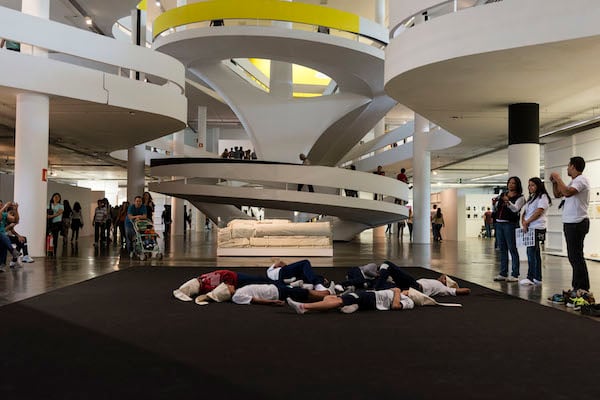
Photo: Leo Eloy / Fundação Bienal de São Paulo.
7. Bienal de São Paulo
The world’s second-oldest biennial after Venice, the Bienal de São Paulo has taken place every other year since 1951, when it was founded by the Brazilian businessman Ciccillo Matarazzo. Since 1957 it has taken place in the Oscar Niemeyer- and Hélio Uchôa-designed Ciccillo Matarazzo Pavilion, which is also the venue for the country’s biggest art fair, SP-arte. Though the Bienal de São Paulo long adhered to the same nation-based organizational model employed by the Venice Biennale, it has since shifted to a more conventional curatorial approach. Its 2014 edition will be curated by Van Abbemuseum director Charles Esche along with Pablo Lafuente, Nuria Enguita Mayo, Galit Eilat, and Oren Sagiv.
Stats Sheet
Year founded: 1951.
Takes place every: Two years.
Current edition: 31st edition (in 2014).
Current curators: Charles Esche, Galit Eilat, Nuria Enguita Mayo, Pablo Lafuente, and Oren Sagiv, with associate curators Benjamin Seroussi and Luiza Proença (in 2014).
Previous curator: Luis Pérez-Oramas , with associate curators Tobi Maier and André Severo, and assistant curator Isabela Villanueva (in 2012).
Countries represented: 33 (in 2012).
Artists included: 110 (in 2012).
Attendance: 520,000 (in 2012).
Important dates: The 31st edition runs September 6 to December 7, 2014.
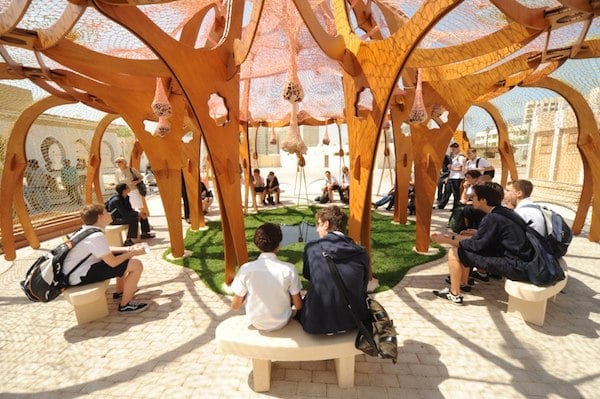
Ernesto Neto, Enquanto a cultura nos separa, a natureza nos une
(While Culture Moves Us Apart, Nature Brings Us Together) (2013).
Courtesy Galeria Fortes Vilaça, São Paulo and Tanya Bonakdar Gallery, New York. Commissioned by Sharjah Art Foundation, Photo: Courtesy Sharjah Art Foundation.
8. Sharjah Biennial
Though the United Arab Emirates have seen an explosion of arts institutions over the past decade, the Sharjah Biennial is a relative dinosaur in the region, having launched in 1993. Founded by Sharjah’s Department of Culture and Information, it has been run since 2006 by the nonprofit Sharjah Art Foundation, which organizes additional visual art programming between biennials. Each edition is organized around a theme that can be either very conceptual—in 2011 co-curators Suzanne Cotter and Rasha Salti, along with associate curator Haig Aivazian, opted for the narrative-driven theme “Plot for a Biennial”—or overtly political, as in 2007’s “Still Life: Art, Ecology, and the politics of Change.” The Sharjah Biennial always maintains a mix of a global focus and an Emirates-specific flavor, tapping top-shelf curators like Eungie Joo—who will curate the 2015 edition—international art stars, and local artists.
Stats Sheet
Year founded: 1993.
Takes place every: Two years.
Current edition: 12th edition (in 2015).
Current curator: Eungie Joo (in 2015).
Previous curator: Yuko Hasegawa (in 2013).
Countries represented: 43 (in 2013).
Artists included: More than 100 (in 2013).
Attendance: 90,000 (in 2013).
Important dates: The 12th edition runs March to June 2015.
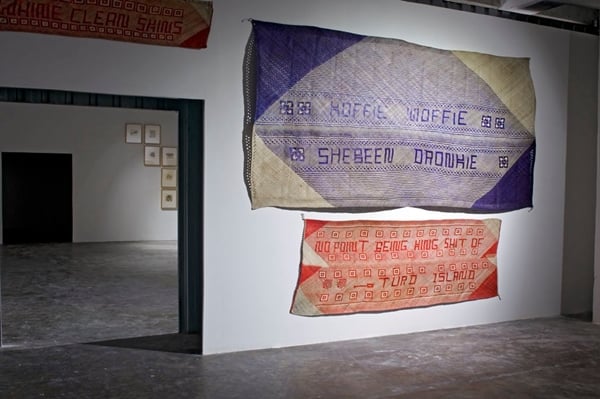
Newell Harry, Untitled Kape Koloured Koon Karnival Cape Coloured Kaapse Klopse (2007).
Photo: Natalie Barki.
9. Istanbul Biennial
Established back in 1987, the Istanbul Biennial’s first two editions were organized by local curator and critic Beral Madra, but since then the exhibition has taken on an increasingly global character, bringing in world-renowned curators like René Block (in 1995), Dan Cameron (in 2003), Adriano Pedrosa, and Jens Hoffmann (who co-curated in 2011), and, in 2007, the Zagreb-based curatorial collective What, How & for Whom. The 2013 edition, which was curated by SKOR Foundation For Art and Public Domain director Fulya Erdemci, had a typical lineup of nearly 90 international and Turkish artists, duos, and collectives gathered under the theme “Mom, am I barbarian?,” among them Thomas Hirschhorn, LaToya Ruby Frazier, Elmgreen & Dragset, Mika Rottenberg.
Stats Sheet
Year founded: 1987.
Takes place every: Two years.
Current edition: 14th edition (in 2015).
Current curator: Carolyn Christov-Bakargiev (in 2015)
Previous curators: Fulya Erdemci (in 2013).
Countries represented: 33 (in 2013).
Artists included: 88 (in 2013).
Attendance: 337,429 (in 2013).
Important date: The 14th edition of the Istanbul Biennial runs September 1 to November 1, 2015.
Infamous moment: The 2013 protests in Istanbul’s Taksim Square began months before the Istanbul Biennial’s official September opening, but the exhibition’s early events and performance program had already begun by June, when protesters began turning up at Biennial events to protest. The target of their actions was the exhibition’s sponsorship by Turkey’s largest conglomerate, Koç Holding A.Ş., whose work in the construction and energy sectors, among others, was considered partly responsible for the widespread feelings of inequality and disenfranchisement that sparked the protests. Scheduled to run from September 10 until November 10 of last year, the biennial’s 13th edition closed on October 20.
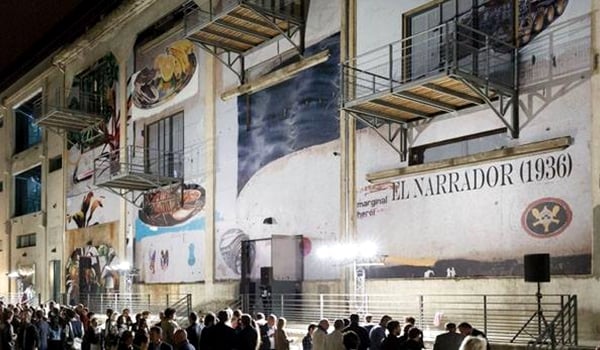
Paulo Nimer Pjota, Permuta entre Dois Estados Temporais (Passage Between Two Temporal States) (2013) at the 12th Biennale de Lyon.
Photo: Courtesy the artist, La Biennale de Lyon.
10. La Biennale de Lyon
Launched in 1991 by the dynamic director of the city’s contemporary art museum, Thierry Raspail, the Lyon biennial has established itself as France’s premier event of the kind. The list of guest curators reads like a Who’s Who. Harald Szeeman gave the biennial a firmly international outlook with his edition focused on “the Other” back in 1997. Since then, curators have tackled big questions such as exoticism (Jean-Hubert Martin, 2000), temporality (Le Consortium de Dijon, 2003), and duration (Nicolas Bourriaud et Jérôme Sans, 2005), working with thematic keywords selected by Raspail for three editions. The 2015–2019 cycle focuses on “modern,” and will be inaugurated by the director of London’s Hayward Gallery, Ralph Rugoff, in September 2015.
Stats Sheet
Year founded: 1991.
Takes place every: Two years.
Current edition: 13th edition (in 2015–16).
Current curator: Thierry Raspail (in 2015–16).
Previous curator: Raph Rugoff (in 2013–14).
Artists included: 52 (in 2013–14).
Attendance: 204,669 (in 2013–14).
Important dates: The 13th edition runs September 10, 2015 to January 3, 2016.
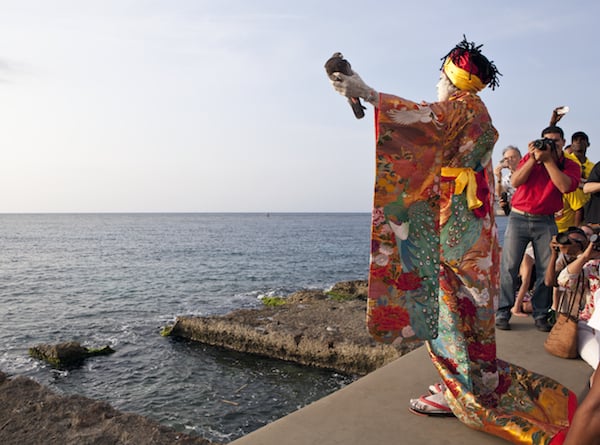
Performance by LLego FeFa in collaboration with street criers, Bakery the Emancipaccion, Havana SMFA students, and the support of Cuban assistants.
Courtesy the artist. Photo: Toshiki Yashiro.
11. Bienal de La Habana
Launched in 1984, Havana’s biennial has distinguished itself by its exclusive focus on non-Western artists. The inaugural edition only included artists from the Caribbean and Latin America, with subsequent iterations expanding to include artists from the Middle East, Africa, and Asia. Another uncharacteristic feature of the Cuban biennial is its curatorial policy: Rather than a rotating cast of globetrotting superstar curators, each edition is overseen by a curatorial team from Havana’s Wifredo Lam Contemporary Art Center. Perhaps as a result of its many-membered committee and its uniquely global approach, the Bienal de La Habana has not always stuck to the biannual schedule implied by its name. The 2002 edition was pushed back to 2003 and the exhibition’s 12th edition, which was due to take place this year, has been postponed to May 2015.
Stats Sheet
Year founded: 1984.
Takes place every: Two to three years—though it was a biennial up through its 2012 edition, in September of 2013 reports surfaced that the 2014 edition was being postponed until 2015, and that the exhibition would henceforth be a triennial.
Current edition: 12th edition (in 2015).
Current curators: The team from Havana’s Wifredo Lam Contemporary Art Center— Jorge Antonio Fernandez Torres, Margarita González Lorente, Nelson Herrera Ysla, José Manuel Noceda Fernandez, Ibis Hernández Abascal, Margarita Sánchez Prieto, Dannys Montes de Oca Moreda, and José Héctor Fernández Portal.
Previous curators: Curators: The team from Havana’s Wifredo Lam Contemporary Art Center.
Countries represented: 45 (in 2012).
Artists included: 180 (in 2012).
Attendance: 50,000 (in 2009).
Important dates: The 12th edition runs May 22 to June 22, 2015.
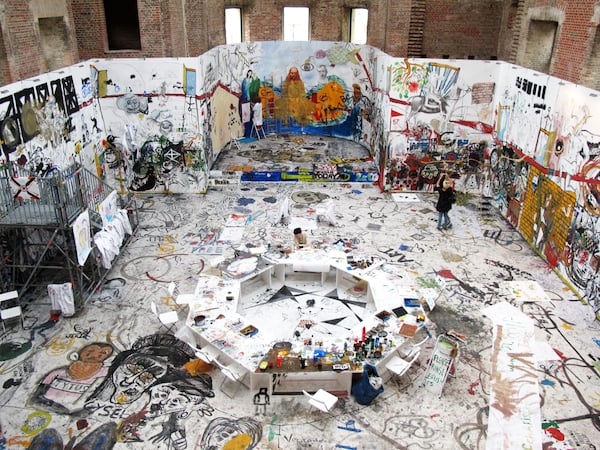
Pawel Althamer’s Draftsmen’s Congress at St. Elisabeth-Church for the Berlin Biennale.
Photo: © Sandra Teitge.
12. Berlin Biennale
The Berlin Biennale’s strengths and weaknesses are typical of its hometown art scene. Sometimes it’s a vibrant curatorial and artistic incubator; other times, it’s an amorphous and disorganized flop. Founded by Klaus Biesenbach, Hans Ulrich Obrist, and Nancy Spector in 1998, it’s been a slingshot for not only their careers but also those of Massimiliano Gioni, who curated the show in 2006 with Maurizio Cattelan and Ali Subotnik, and Documenta 14’s Adam Szymczk, who with newly appointed Kunsthalle Basel director Elena Filipovic curated the 2008 edition. Centered on the KW Institute for Contemporary Art, the biennial’s most successful shows have been those that focus more on the artists rather than on a massive thematic overture. Again, this plays to Berlin’s strengths rather than trying to circumvent its weaknesses. To that end, anticipation is high for Juan Gaitan’s 2014 edition, opening at the end of May.
Stats Sheet
Year founded: 1998.
Takes place every: Two years.
Current edition: 8th edition (in 2014).
Current curator: Juan A. Gaitán (in 2014).
Previous curator: Artur Żmijewski, with associate curators Joanna Warsza and the Voina art collective (in 2012).
Countries represented: 22 (in 2012).
Artists included: Approximately 50 (in 2012).
Attendance: 120,000 (in 2012).
Important dates: The 8th edition runs May 29 to August 3, 2014.
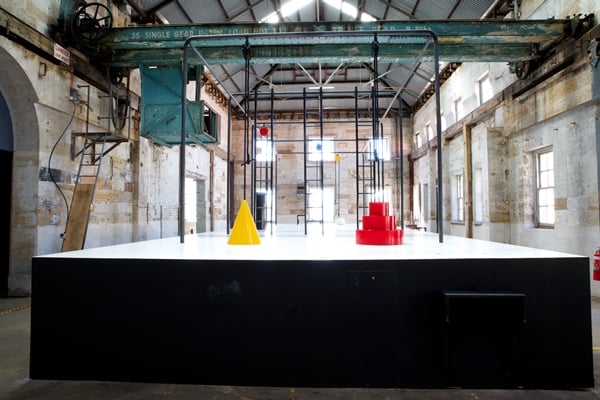
Mel O’Callaghan, Parade (2014). Installation view of the 19th Biennale of Sydney at Cockatoo Island.
Courtesy the artist; Galerie Allen, Paris; and Galeria Belo-Galsterer, Lisbon. Created for the 19th Biennale of Sydney.
Photo: Ben Symons.
13. The Biennale of Sydney
The Southern Hemisphere’s second-oldest biennial has been around since 1973, and has become an exceptionally international, sprawling affair, bringing large-scale projects by dozens of artists to sites all around Sydney, from conventional venues like the Museum of Contemporary Art and the Art Gallery of New South Wales, as well as the Royal Botanic Gardens, to a former prison on Cockatoo Island, refurbished piers in Walsh Bay, and, naturally, the Sydney Opera House. Over the years it has been helmed by some of the biggest curators around, including Lynne Cooke—who curated the fantastically titled 1996 edition, “Jurassic Technologies Revenant”—artist and curator Richard Grayson (in 2002), and Carolyn Christov-Bakargiev (in 2008). The Biennale of Sydney’s current edition, curated by the director of Melbourne’s Australian Centre for Contemporary Art, Juliana Engberg, boasts a characteristic mix of works and projects by Australian artists like Mel O’Callaghan, James Angus, Susan Norrie, and Benjamin Armstrong, and international stars such as Tacita Dean, Martin Boyce, Douglas Gordon, Roni Horn, and Pipilotti Rist.
Stats Sheet
Year founded: 1973.
Takes place every: Two years.
Current edition: 19th edition (in 2014).
Current curator: Juliana Engberg (in 2014).
Previous curators: Catherine de Zegher and Gerald McMaster (in 2012).
Countries represented: 31 (in 2014).
Artists included: 92 (in 2014).
Attendance: 665,000 (in 2012).
Important date: The 19th edition closes June 9, 2014.
Infamous moment: The opening of the current Biennale of Sydney was overshadowed by calls to boycott the exhibition over its lead sponsor, Transfield Holdings, which, among other activities, runs overseas detention centers for refugees and people seeking asylum in Australia. In February more than 30 artists, including many of the participants in this year’s Biennale, signed a letter calling on the exhibition’s board of directors to end its sponsorship agreement with Transfield, which the Biennale did the following month.
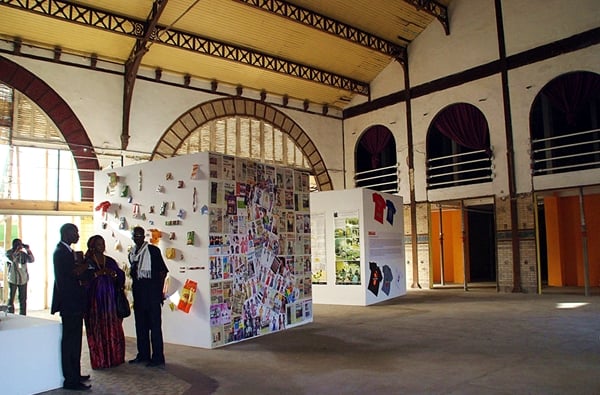
Installation at the 2012 DAK’ART.
Photo: Lucie Falque-Vert.
14. DAK’ART
Originally conceived in 1989 as a biennial that would alternate between visual art and literature, the Dakar Biennale eventually rebranded in 1996 to devote itself exclusively to contemporary African art. DAK’ART aims to complicate expectations of what contemporary African art ought to look like or be about—the current edition, for instance, has been praised for presenting a number of works that address the difficulties of being openly gay in Africa—and typically features a few of the continent’s internationally known art stars alongside a slew of locally renowned artists who have not had much global exposure. This year’s edition, for instance, was curated by Elise Atangana, Abdelkader Damani, Smooth Ugochukwu, and Massamba Mbaye around the theme “Producing the Common,” and includes works by the likes of Radcliffe Bailey, Simone Leigh, Julie Mehretu, and Wangechi Mutu.
Stats Sheet
Year founded: 1990.
Takes place every: Two years.
Current edition: 11th edition (in 2014).
Current curators: Elise Atangana, Abdelkader Damani, and Smooth Ugochukwu Nzewi (in 2014).
Previous curators: Christine Eyene, Nadira Laggoune, and Riason Naidoo (in 2012).
Artists included: 61 (in 2014).
Attendance: 30,000 (in 2012).
Important date: The 11th edition runs until June 8, 2014.
Infamous moment: After a standout 2006 edition, the European Union—one of DAK’ART’s major funders—pulled its support for the 2008 biennial, resulting in a much smaller exhibition that was hurriedly organized.
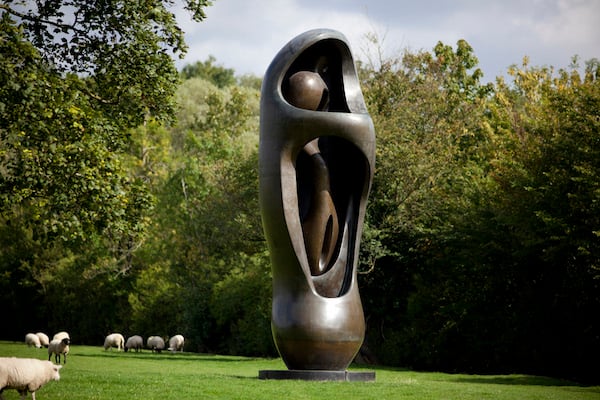
Henry Moore, Large Upright Internal/External Form (1981–83), The Henry Moore Foundation.
Photo: Jonty Wilde.
15. Liverpool Biennial
The self-proclaimed “UK Biennial for Contemporary Art” has much to do with the reinvention of a city still suffering from its decline as an international port. The empty buildings found pretty much everywhere in Liverpool have provided excellent and unusual exhibition spaces for the biennial, which also acts as a commissioner of temporary and permanent artworks. These include Richard Wilson’s spectacular Turning the Place Over (2008), for which the artist cut out and twisted a round section in the façade of a derelict building. The biennial has been going since 1998, and was taken over in 2012 by the much-loved Sally Tallant, formerly of the Serpentine Gallery. Opening on July 5, the next edition is curated by Mai Abu ElDahab and entitled “A Needle Walks Into a Haystack.”
Stats Sheet
Year founded: 1998.
Takes place every: Two years.
Current edition: 8th edition (in 2014).
Current curator: Mai Abu ElDahab and Anthony Huberman (in 2014).
Previous curator: Sally Tallant (in 2012).
Countries represented: 34 (in 2014).
Artists included: 64 (in 2014).
Attendance: More than 600,000.
Important dates: The 8th edition runs July 5 to October 26, 2014.
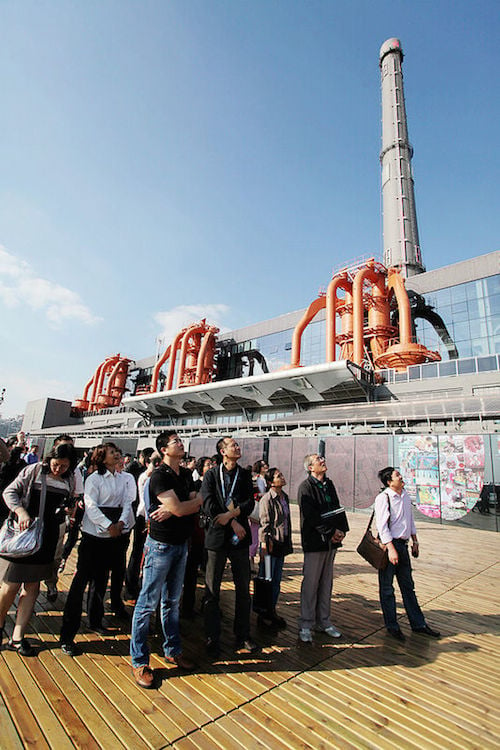
Visitors at the Shanghai Biennale.
Photo: Wahg Yuning, courtesy Hanart TZ Gallery.
16. Shanghai Biennale
China’s biggest biennial has been around since 1996, when the Shanghai Art Museum hosted its inaugural outing. Since then the exhibition has remained focused at that venue, with additional public projects, performances, talks, and extra programming spreading throughout the city. While it has never tried to replicate the nation-based pavilion system of the Venice Biennale, the Shanghai Biennale’s 2012 edition—curated by Qiu Zhijie along with co-curators Boris Groys, Jens Hoffmann, and Johnson Chang—was organized around a set of city pavilions ranging from Auckland and Brooklyn to Tehran and Vancouver. The 10th edition, slated to open in November, is being curated by Anselm Franke.
Stats Sheet
Year founded: 1996.
Takes place every: Two years.
Current edition: 10th edition (in 2014).
Current curator: Anselm Franke (in 2014).
Previous curators: Qiu Zhijie, Jens Hoffman, Boris Groys, and Johnson Chang (in 2012).
Countries represented: 23 (in 2012).
Artists included: 98 (in 2012).
Attendance: 380,000 (in 2012).
Important dates: The 10th edition runs November 22, 2014 to March 31, 2015.
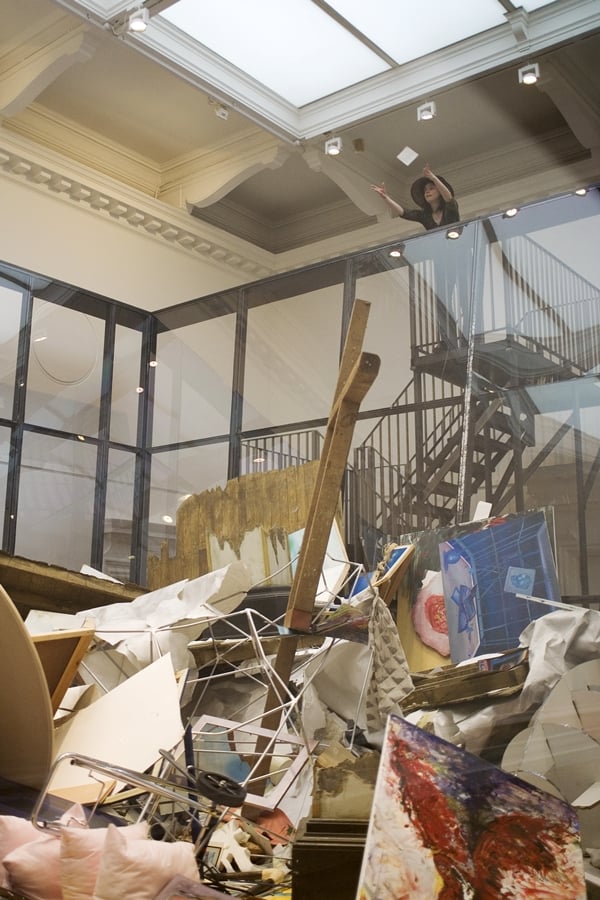
Michael Landy, Art Bin (2010). Installation view at South London Gallery.
Photo: Courtesy the artist.
17. Yokohama Triennale
Japan’s most prominent recurring international exhibition pairs some of the biggest Asian artists of the moment—including a predictably strong Japanese contingent—with European and US artists. The Triennale is the centerpiece of the Creative City Yokohama initiative, launched in 2004, which aims to make art and culture a priority in the port city’s development. The exhibition’s fourth edition took place shortly after the 2011 tsunami that devastated the Japanese coast, giving additional poignancy to that year’s theme—Japan’s relationship to the rest of the world. The fifth Yokohama Triennale, which is being curated by the artist Yasumasa Morimura and opens in August, carries the very literary and mournful title “ART Fahrenheit 451: Sailing into the sea of oblivion.” The exhibition will unfold in a quasi-narrative format divided into 11 chapters and an introduction, with artists engaging ideas of loss, oblivion, and remembrance.
Stats Sheet
Year founded: 2001.
Takes place every: Three years.
Current edition: 5th edition (in 2014).
Current curator: Yasumasa Morimura (in 2014).
Previous curator: Miki Akiko (in 2011).
Countries represented: 19 (in 2014).
Artists included: 62 (in 2012).
Attendance: Approximately 330,000 (in 2011).
Important dates: The 5th edition runs August 1 to November 3, 2014.
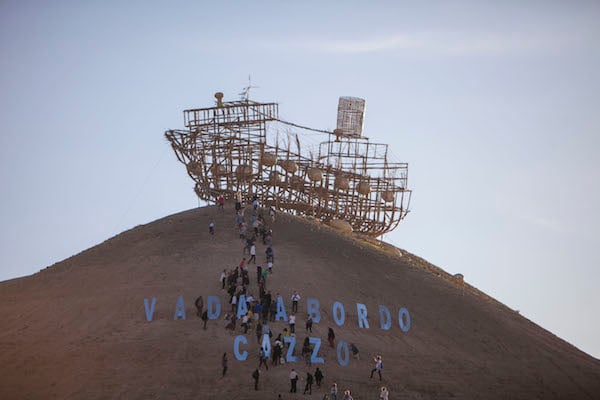
Alexandre Ponomarev, Voice of the Wilderness (2014). Commissioned by Marrakech Biennale 5.
Photo: Achraf Benaoud.
18. Marrakech Biennale
The fifth edition of the Moroccan biennial, titled “Where are we now?,” closed in March. Hicham Khalidi, an independent curator and the former artistic director of the Institute for Audiovisual Art in The Hague, handled its visual art component. One of the things that distinguishes Marrakech from other biennials is its multidisciplinarity, with sections devoted to film and video, performing arts, and literature, each with their own dedicated curator. This partly accounts for its exceptionally high count of participating artists (452 this year). Another unique feature of the Marrakech Biennale is its tri-lingual format, with works and texts presented in Arabic, French, and English. The expansive exhibition blends into its surroundings more thoroughly than many other biennials, with projects presented in centuries-old temples, Colonial-era buildings, an unfinished theater, and the local art museum, among other venues spread throughout the city.
Stats Sheet
Year founded: 2005.
Takes place every: Two years.
Current edition: 5th edition (in 2014).
Current curators: Hicham Khalidi, Khaled Tamer, Driss Ksikes, and Jamal Abdennassar (in 2014).
Previous curators: Nadim Samman and Carson Chan (in 2012).
Countries represented: 25 (in 2014).
Artists included: 452 (in 2014).
Attendance: More than 43,000 (in 2014).
Important dates: The 5th edition closed March 31, 2014.
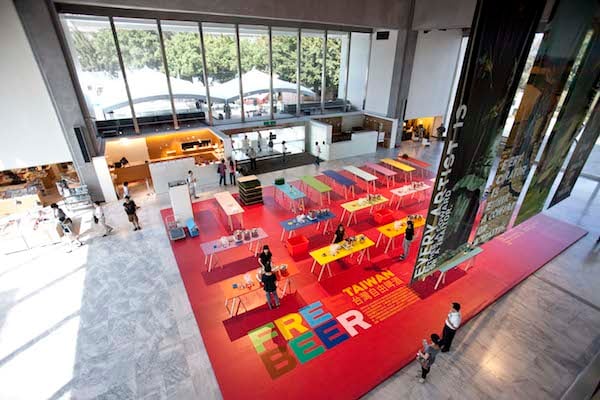
Superflex FREE BEER Factory (Installation view) (2008) at Taipei Biennial 2010.
Photo: © Taipei Fine Arts Museum.
19. Taipei Biennial
Though officially launched by the Taipei Fine Arts Museum in 1992, the Taipei Biennial existed in embryonic form as early as 1984, when the museum hosted a pair of recurring exhibitions focused on contemporary art in China. The biennial took on its present form after the 1996 edition, when it began inviting internationally renowned curators to take the helm and started to internationalize the roster of artists involved. This began gradually, with the 1998 edition (curated by Nanjo Fumio) bringing together artists from Taiwan, China, South Korea, and Japan. The 2000 Taipei Biennial, co-curated by Jerome Sans and Manray Hsu around themes of hybridity and remix culture, was truly (appropriately) global, with participants including Erwin Wurm, Liza Lou, Jonathan Monk, Wang Du, and more. Subsequent editions have continued in this very international vein, with a succession of top-shelf curators taking the helm, including Anselm Franke (in 2012), Dan Cameron (who co-curated with Jun-jieh Wang in 2006), and Fumio Nanjo (in 2004).
Stats Sheet
Year founded: 1992.
Takes place every: Two years.
Current edition: 12th edition (in 2014–15).
Current curator: Nicolas Bourriaud (in 2014–15).
Previous curator: Anselm Franke (in 2012–13).
Countries represented: 33 (in 2012–13).
Artists included: 47 (in 2012–13).
Attendance: 178,594 (in 2012–13).
Important dates: The 12th edition runs September 13, 2014 to January 4, 2015.
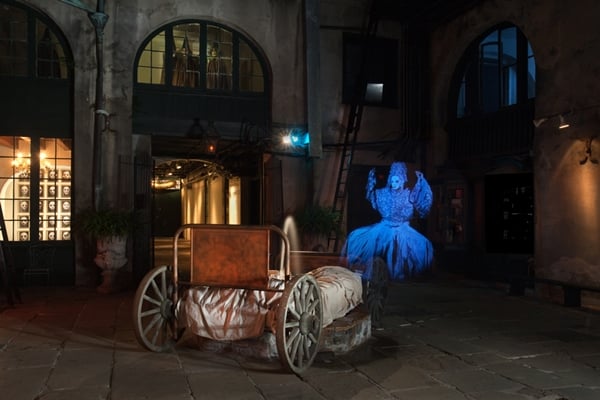
Dawn DeDeaux, Goddess Fortuna And Her Dunces In An Effort To Make Sense Of It All (2011). installation for Prospect.2. New Orleans.
Photo: © Michael Smith, courtesy Prospect New Orleans.
20. Prospect New Orleans
Conceived by curator Dan Cameron in the wake of 2006’s devastating Hurricane Katrina, Prospect New Orleans was intended to help spark the city’s rejuvenation. Prospect.1 launched in 2008 with a budget of $4.5 million and an ambitious lineup of projects by 81 artists installed throughout the still-devastated city. Although the first show was praised by critics, Cameron’s nonprofit US Biennial Inc. ended up $900,000 in debt. Since then the exhibition has struggled; Prospect.2, which opened in late 2011 with a budget of roughly $2.5 million and just 25 artists, had a more lukewarm reception, and Prospect.3 has been pushed back from 2013 to the fall of 2014. But with new executive director Brooke Davis Anderson, LACMA’s head of contemporary art Franklin Sirmans at the helm, and an impressive lineup of artists including Theaster Gates, Camille Henrot, Will Ryman, Carrie Mae Weems, Tavares Strachan, for its third edition, Prospect New Orleans appears poised to right its course.
Stats Sheet
Year founded: 2008.
Takes place: Irregularly.
Current edition: 3rd (in 2014–15).
Current curator: Franklin Sirmans (in 2014–15).
Previous curator: Dan Cameron (in 2008–09 and 2011–12).
Countries represented: 24 (in 2014–15).
Artists included: 62 (in 2014–15).
Attendance: 72,205 (in 2011–12).
Important dates: Prospect.3 runs October 25, 2014 to January 25, 2015.
Infamous moment: As mentioned above, the ambitious and critically praised Prospect.1 put organizer and curator Dan Cameron’s US Biennial Inc. $900,000 in debt. As a result, Prospect.2 was delayed and drastically scaled back.